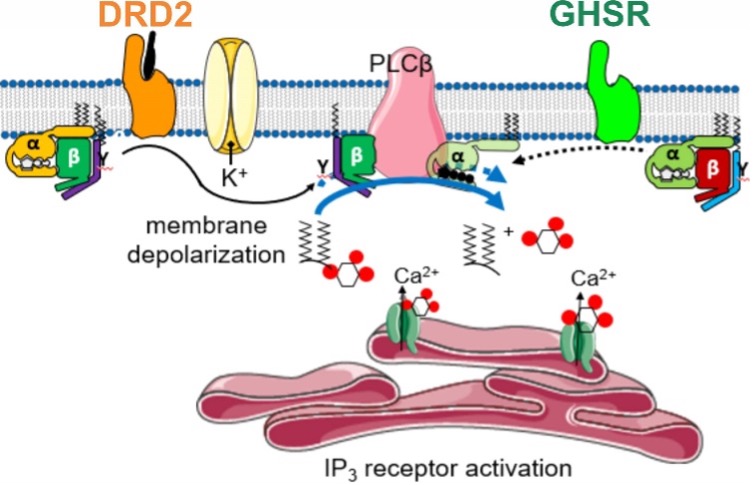Novel heteromeric receptors: ghrelin receptors and dopamine receptors working together
-
Project Leader/Supervisor

Professor John Furness
Project Details
Ghrelin is a naturally occurring hormone that had been thought to be a transmitter in the central nervous system (CNS), and some years ago we discovered that ghrelin is a powerful CNS-acting stimulant of defecation in animal models and humans. A striking conclusion from our discoveries is that the strong stimulation of defecation by ghrelin agonists is independent of ghrelin, which we discovered to be absent from the CNS. Our data indicate that the physiological activation of the ghrelin receptor, GHSR, is through dopaminergic transmission acting at interacting GHSR / dopamine 2 receptor (DRD2). In this project we are investigating how ghrelin and dopamine receptor agonists act and interact at this receptor complex in biophysical systems, isolated cells, native cells and whole animals.
Our current model:

Researchers
- Project supervisors: Professor John Furness
- Project members: Dr Mitchell Ringuet, Dr Sebastian Furness, Dr Farhad Deoki, Billie Hunne
Collaborators
Dr Akhter Hossain (Florey Institute)
Research Publications
Furness JB, Pustovit RV, Syder AJ, Ringuet MT, Yoo EJ, Fanjul A, Wykosky J, Fothergill LJ, Whitfield EA, Furness SGB: Dopamine and ghrelin receptor co-expression and interaction in the spinal defecation centres. Neurogast Motil 33, e14051 (2021) doi.org/10.1111/nmo.14051
Ringuet MT, Furness JB, Furness SGB: G protein-coupled receptor interactions and modification of signalling involving the ghrelin receptor, GHSR1a. J. Neuroendocrinology 34, e13077 (2022). https://doi.org/10.1111/jne.13077
Research Group
Furness laboratory: Digestive physiology and nutrition
Faculty Research Themes
Neuroscience, Infection and Immunology
Key Contact
For further information about this research, please contact the research group leader.
Department / Centre
MDHS Research library
Explore by researcher, school, project or topic.